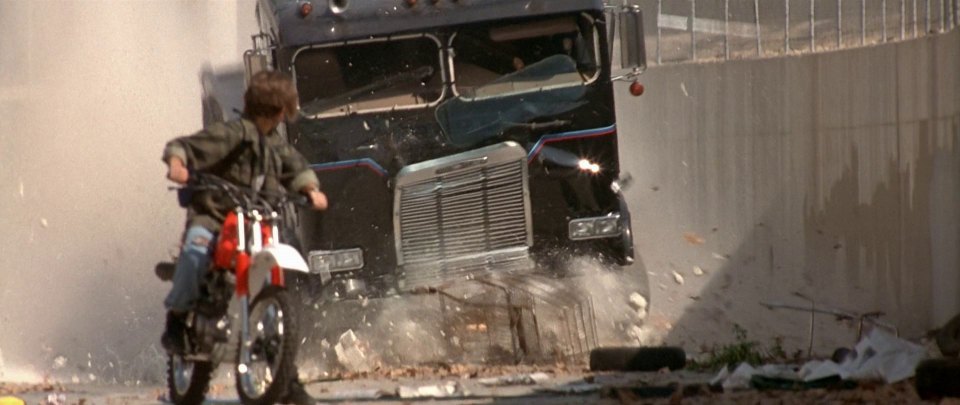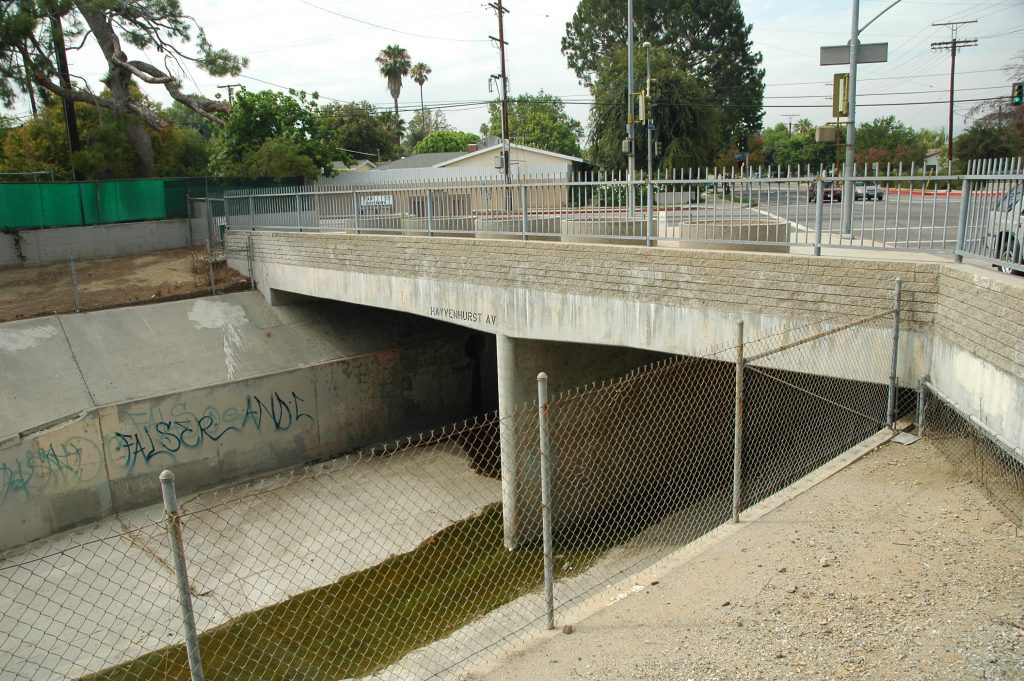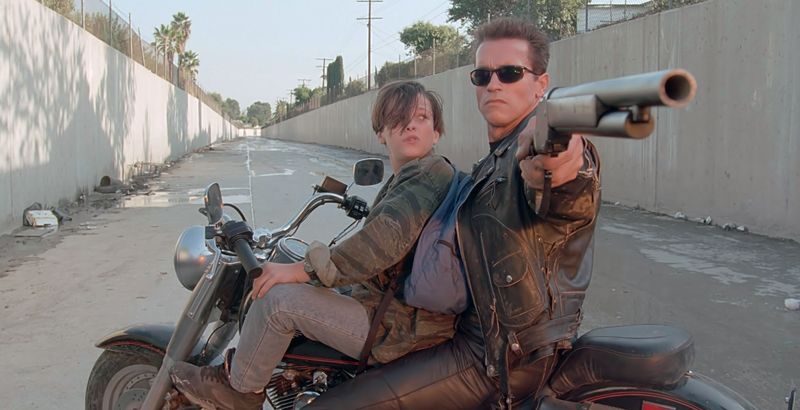Behind the scenes of the making of T2’s iconic canal chase scene.
With the recent rerelease of Terminator 2: Judgment Day 3D in cinemas and its upcoming Blu-Ray release, we take a look back behind the scenes of the filming of the jaw dropping canal chase scene, one of the film’s many jaw dropping action scenes. Filmed in San Fernando Valley’s Bull Creek, the scene immediately conveys what a vast task taking on Robert Patrick’s T-1000 will be for the Connors and their new reprogrammed T-800 protector (Arnold Schwarzenegger). The scene has the T-1000 driving a Freight liner semi-tow truck in a relentless pursuit of John Connor (Edward Furlong) who is desperately trying to escape on a small trials motorcycle through the Los Angeles Drainage Canal System, with his eventual rescue coming from the T-800 on his 1990 Harley Davidson Fat Boy (model FLSTF).

The scene is said to have come about after director James Cameron came up with the idea of how the T-1000’s liquid morphing abilities would first be showcased to the audience, with him stating that he had first envisioned the sequel’s villain emerging from the wreckage of a burning truck. Cameron has previously revealed how he came up with the original idea of The Terminator through a fever induced dream in Rome and was convinced that he should stick with his vision as a result.

Cameron had considered several actors for the part prior to the casting of Robert Patrick. Early production storyboards and character concept art were said to feature rock star Billy Idol who eventually ruled himself out of the role when he suffered a leg injury following a motor cycle accident. Ironically, the character is shown riding a motorcycle in the movie and it is hard now to imagine any other actor playing the role however, it was almost a case of a complete role reversal, in one very early idea that would involve the hero of the original film, Kyle Reese’s image being used by Skynet as the model for the T-1000. This would have featured the return of actor Michael Biehn but the idea was eventually ruled out by Cameron as he felt that it may be too confusing for the audience to see their previous hero now assuming the role of the assassin. A then record high budget of just over $100 million was allocated to the film’s production, with nearly half of that being spent on special effects and live action sequences.

Although the canal chase appears to be all shot in one location it actually encompassed over ten miles of terrain and the scene is the result of some clever editing. Clocking in at just over four minutes, the chase is one of the film’s standout scenes, filled with amazing drama and is all the more impressive when you consider the amount of practical effects that it includes. The main opening stunt involved the Freight liner jumping from the high rise freeway into the canal’s dry surface. To achieve this the stunt crew created a large false wall for the truck to come crashing through. This also concealed the large ramp that was required for the vehicle to gain sufficient elevation during the jump. With a long run up to gain momentum the truck is seen smashing through the newly built wall and crash landing onto the canal’s drained surface to then continue its pursuit of John Connor who is fleeing on his small motorcycle.

This location was also utilised as the entry point for the T-800’s huge motorcycle jump, which took place just to the left of the truck’s jump point. Cameron was insistent that the stunt take place using the actual Harley Davidson rather than a stripped down, lighter vehicle as had been the norm with such stunts in previous productions, feeling that it would pull the viewer away from the shot. This required clever use of two construction cranes by stunt coordinator Joel Kramer to the left and right and out of shot, 600 feet apart with a one inch cable tethered between the two which was then attached with an eight foot spreader bar in its centre and the motorcycle, complete with stunt man Peter Kent on board, was then hung on it like a marionette. A further cable was then attached to a truck out of of shot on the canal surface, which pulled Kent on the vehicle off the bridge at 35 mph, causing him to sail 85 feet through the air before the vehicle landed. The cable between the crane allowed only 185 pounds of impact upon its landing, which stopped the motorcycle from breaking apart and causing serious injury to the stuntman. The combined weight of the motorcycle alone was 780 pounds and this is without factoring in the weight of Kent, who as a stunt double for a former Mr Universe, was hardly on the small side. The stunt looks amazingly realistic on screen with the removal of the wires made possible by digital effects editing and the stuntman is clearly proud of his achievement;
“It was a nice moment. My motorcycle work and the bike jump put me in the Hollywood Stuntman’s Hall of Fame and is rated by CNN as one of the top ten stunts of all time. That’s something that no one can ever take away from you.”

Early on during the scouting for the chase, the stunt crew came up against a literal roadblock when they discovered that none of the low level bridges on the canal had an underpass high enough to clear the passing truck. Never one to buck a challenge, Cameron’s decision was simply to slice the top of the vehicle off as it passed underneath and as a result the vehicle’s roof was then pre-rigged to crumple and shear off upon impact. Again the crew were faced with another problem as when they’d been looking for a location for the finale of the chase, none of the bridges had a concrete divider for the truck to crash into, so they had to physically build a temporary structure out of concrete and ensure it blended in to the scenery in order to film the shot of the truck colliding with it. In the finished scene, an electric spark and a fuel leak then causes the vehicle to burst into flames only then for the T-1000 to emerge from the flames in his liquid metal form shortly afterwards, amazing audiences with the film’s then cutting edge CGI effects, created by Industrial Light & Magic.

One thing the director also wanted was that the scene feature Arnold’s T-800 using a weapon in a way that had not been seen since the days of the westerns, with the twirling of his shotgun in one hand, reloading the weapon whilst riding a Harley Davison in place of a horse. To do this, weapons master for the production Harry Lu was briefed in pre-production by Cameron and recalled;
“James was looking at the The Rifleman and some other old westerns. He told me that he wanted Schwarzenegger’s shotgun to to be able to twirl like how a cowboy on the shows did with their six shooters.”
In response to Cameron’s request, Lu suggested that a sawed-off 1887 Winchester 12-gauge shotgun would work well but stated that shortly afterwards he regretted his decision;
“After I opened my mouth, I kicked myself in the butt!”
The weapon required a lot of custom work by Lu, with him spending a month and a half having to play with the weight distribution, balance and more importantly the internal mechanism of the rifle.
“It’s one of those things that the audience doesn’t think about, but the shotgun shell worked with a pull cable and every time the gate opened, the shell wants to fly out. So I finally found a way to correct that” said Lu.
With his finished project complete, Lu also had to then train Schwarzenegger to use it, having created a larger loop on the gun so the actor could use it and he recalled how impressed he was with the actor’s dedication to the scene;
“I went to his house and showed him how to use it and we practised constantly. He was actually able to take it on pretty fast.”

Director Cameron also recalled that during one day on set Arnold had made the mistake of picking up the wrong gun to give it a practice twirl and almost broke his fingers in the process but laughed off the incident and proceeded to carry on his practice with the correct weapon. The practice paid off and Arnold is seen to make the action look effortless when he is seen flip-cocking the weapon whilst riding the Harley Davidson. The actor is well known for his commitment to his roles and once famously stated,
“I have a love interest in every one of my films – a gun”.

Sources:
Business Insider Australia; Uproxx; Beyond the marquee; Entertainment Weekly.

